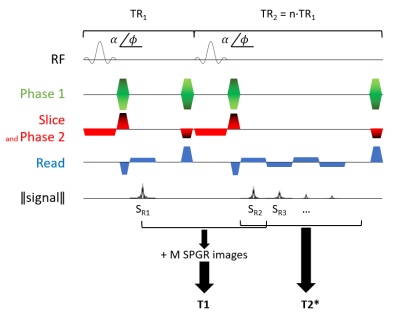Marco Andrea Zampini1,2, Jan Sijbers3, Marleen Verhoye2, and Ruslan Garipov1
1MR Solutions Ltd, Guildford, United Kingdom, 2Department of Biomedical Sciences, University of Antwerp, Wilrijk, Belgium, 3Department of Physics, University of Antwerp, Wilrijk, Belgium
1MR Solutions Ltd, Guildford, United Kingdom, 2Department of Biomedical Sciences, University of Antwerp, Wilrijk, Belgium, 3Department of Physics, University of Antwerp, Wilrijk, Belgium
RAMSES is a new 3D sequence for simultaneous T1 and T2* mapping based on toggling readout modality between mono- and multi-gradient echo. Based on spoiled gradient-echo acquisitions, it is a time-efficient method for robust quantitative MRI.

Figure 1: RAMSES pulse sequence diagram and parameter estimation scheme. With a Cartesian acquisition scheme, each k-space line is sampled during TR1 and TR2 with a mono- and multi-gradient echo, respectively. RF spoiling is employed by incrementing pulse phase φ while gradient spoiling takes place after data acquisition in read-only direction. Rewinder gradients are played in both phase directions.

Figure 3: Estimated T1 and T2* mean and standard error values of the phantoms (gelatin and Gd-DOPA solutions) for RAMSES and their relative ground truth estimated via Inversion Recovery for T1 and multi-echo gradient-echo for T2*. Similar T1 values for Gd-DOTA solutions are found in Shen et al.10 although solvent and temperature were different (human blood at 37°C against water at room temperature).
